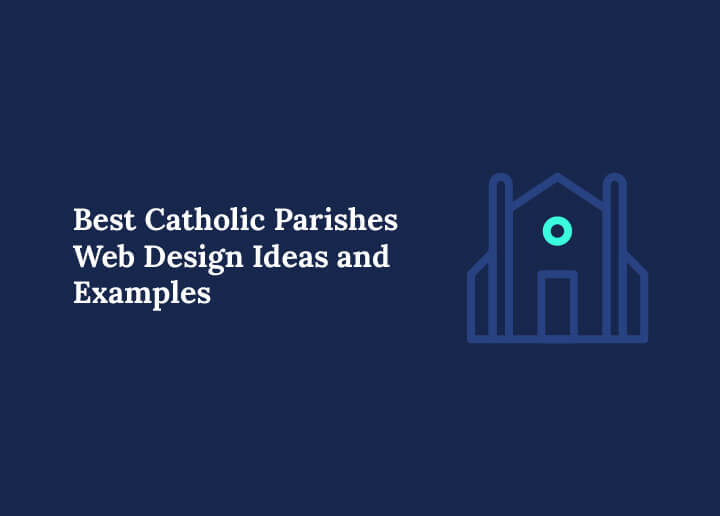Many Catholic parishes have websites that are hard to navigate, outdated, or simply uninviting. This can make it difficult for parishioners to find mass times, register for events, or donate online. The good news? A well-designed parish website can transform this experience, creating a welcoming digital space that reflects your mission and engages your community.
In this article, we’ll share inspiring Catholic parish website design ideas and examples, showing how clarity, beauty, and functionality can work together to build an online presence that strengthens faith, connection, and engagement.
Importance of Church Websites
When Sarah moved to a new city, she wanted to find a local parish. She turned to Google, only to land on a website that was confusing, outdated, and difficult to navigate. Frustrated, she almost gave up.
This story highlights why church websites are no longer optional; they are essential for welcoming visitors and connecting with the community. A thoughtfully designed parish website can be a virtual front door, providing vital information while fostering engagement and spiritual growth.
Create a Welcoming Online Presence
Church websites serve as the first point of contact for parishioners, newcomers, and even those exploring faith for the first time. Through clear design, friendly messaging, and intuitive navigation, a website can immediately convey warmth and hospitality, inviting visitors to engage with the parish both online and in person.
Engage Your Community
Beyond basic information, an effective church website encourages interaction. Features like event calendars, ministry updates, and volunteer opportunities help leaders connect with members, promote parish life, and strengthen community bonds.
Inspire and Inform Visitors
Many parishes have successfully built visually appealing and user-friendly websites that communicate their mission. Incorporating elements such as beautiful photography, videos, and stories of parish life can inspire visitors and encourage participation.
Best Practices in Action
Some of the most effective church websites prioritize usability and accessibility. Clear navigation, mobile-friendly design, and online giving options ensure that visitors can quickly find what they need and contribute to the parish mission seamlessly.
By combining a welcoming design with practical functionality, a parish website becomes more than an information hub; it becomes a dynamic tool for engagement and growth.
Bring Your Mission Online with Purpose-Driven Web Design
Whether you’re a church, school, or nonprofit, we design user-friendly websites that highlight your mission, engage your community, and inform supporters.
Catholic Parish Church Website Design Ideas and Inspiration
Designing a Catholic parish website requires more than just technical skills; it’s about reflecting the parish’s identity and mission while creating an inviting online space.
By drawing inspiration from existing resources and aligning design with parish values, churches can build websites that truly engage their communities.
Finding Inspiration from the Right Sources
Before beginning the design process, it’s helpful to explore creative ideas from trusted resources.
- Parish Websites: Look at successful parish websites to see how they structure content and engage visitors.
- Web Design Experts: Professional designers can provide insights into user experience, layout, and functionality.
- Online Research: Blogs, case studies, and design showcases offer endless inspiration to spark creativity.
Designing with Mission, Values, and Audience in Mind
Every parish has a unique mission and community, and the website should reflect that identity.
- Mission-Driven Design: The look and feel should align with the parish’s values, emphasizing faith and community.
- Audience-Centered Features: Content must address the needs of families, young adults, and older parishioners alike.
- Consistent Branding: Fonts, colors, and imagery should mirror the parish’s personality and tradition.
Enhancing Engagement Through Visuals
Visual storytelling makes a parish website more memorable and inspiring.
- Photography: Authentic images of parish life build trust and connection.
- Videos: Recorded sermons, testimonials, or event highlights add a dynamic touch and strengthen engagement.
Best Practices for Parish Websites
Beyond inspiration and visuals, following proven practices ensures long-term success.
- Clarity of Information: Mass times, events, and ministries should be easy to access.
- Community Outreach: Highlight service projects and opportunities for involvement.
- Fresh Content: Regular updates with news, blogs, and event posts keep visitors engaged and returning.
Read: Best Website Builders for Churches
Best Examples of Well-Designed Parish Websites in the USA
Some Catholic parishes in the USA have set remarkable examples by creating websites that balance beauty, clarity, and functionality.
These sites demonstrate how thoughtful design can make information easy to access while fostering engagement and spiritual growth.
St. Patrick’s Cathedral: New York City, New York
St. Patrick’s, one of the most iconic Catholic churches in the USA, has a website that reflects its global presence.
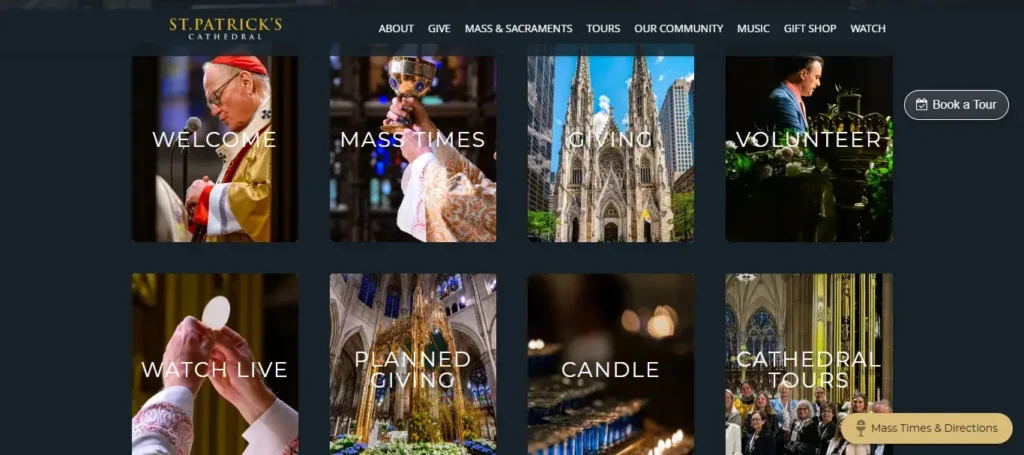
- Global Accessibility: Multilingual support caters to diverse visitors.
- Virtual Experience: A virtual tour allows visitors worldwide to explore the cathedral online.
- Strong Branding: The site reflects the grandeur and history of the cathedral while providing modern features like online giving and livestreamed Mass.
Holy Family Catholic Church: Orlando, Florida
Holy Family’s website reflects warmth and hospitality through its clean design and intuitive navigation.
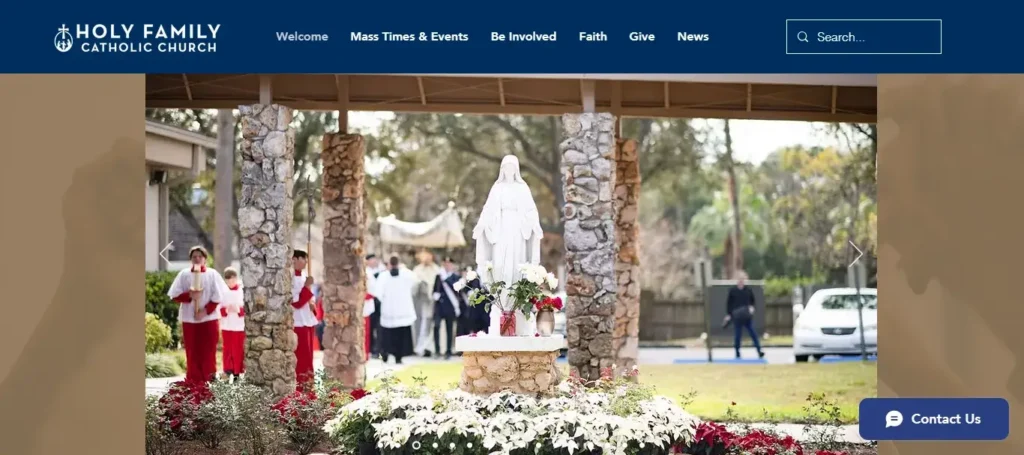
It includes:
- Clear Information: Mass times, confessions, and contact details are easy to find on the homepage.
- Visual Appeal: Beautiful photography showcases parish life, creating an inviting feel.
- Digital Engagement: Online giving and livestreamed Mass options connect with parishioners who can’t attend in person.
Our Lady of Sorrows Catholic Church: Birmingham, Alabama
Our Lady of Sorrows demonstrates how simplicity can be powerful.
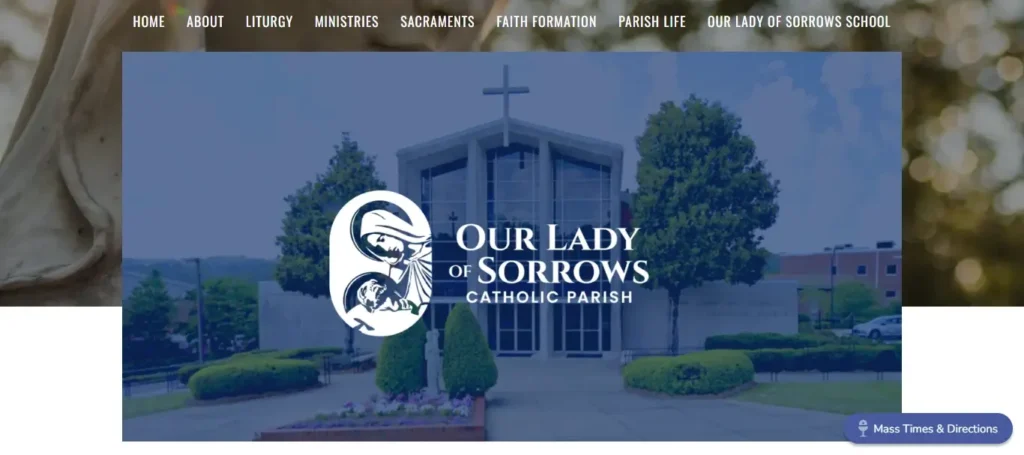
- Straightforward Layout: Essential information like mass times and contact details are displayed upfront.
- Family-Oriented Features: Dedicated pages for children’s ministries and faith formation.
- Accessibility: A mobile-friendly design ensures easy browsing across devices.
Beginner’s Guide: How to Make WordPress Accessible
St. Francis of Assisi Catholic Church: Raleigh, North Carolina
This parish website reflects the vibrancy of its community and mission-driven focus.
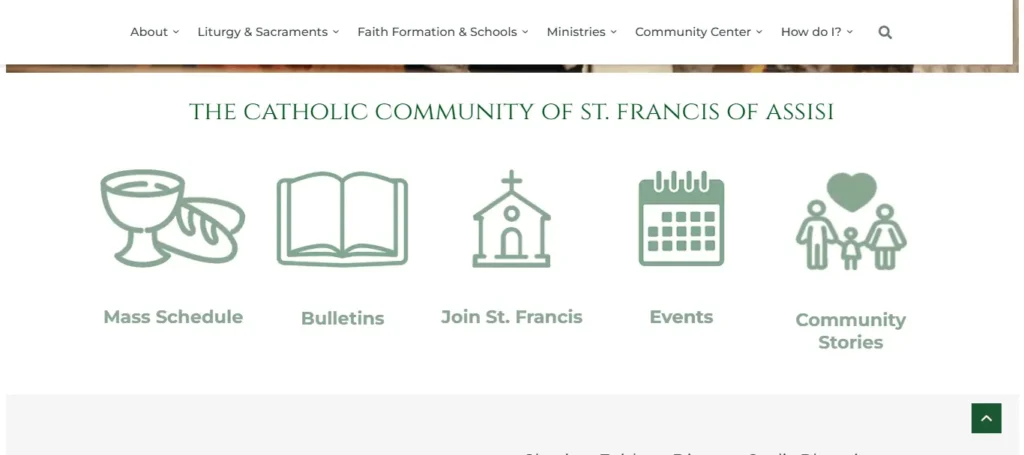
- Mission Integration: Parish values are embedded in the design and messaging.
- Media-Rich Content: Videos, podcasts, and galleries highlight parish life and outreach.
- User-Friendly Navigation: Menus are simple, ensuring that even first-time visitors can find what they need.
Read: Best Church WordPress Themes
Basilica of St. Mary: Minneapolis, Minnesota
The Basilica’s website blends history with modern digital engagement.
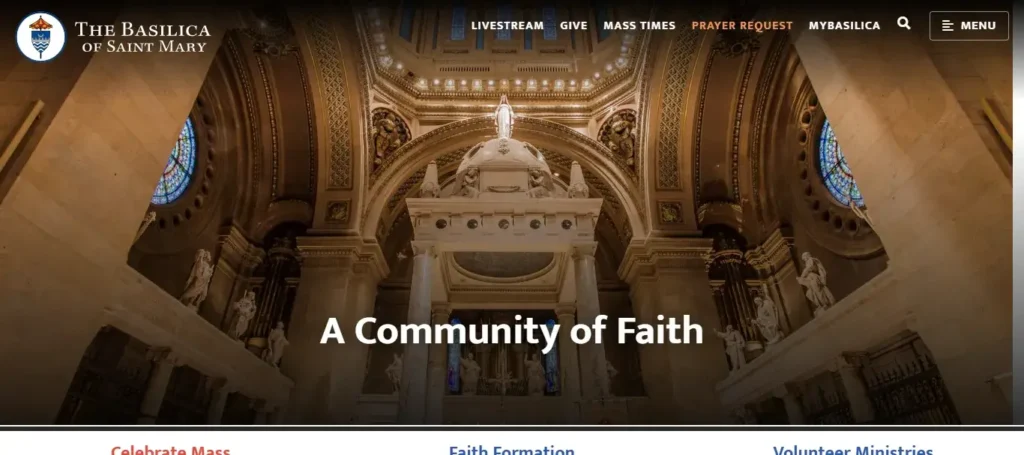
- Heritage Showcase: Stunning visuals highlight the parish’s historic architecture.
- Engagement Tools: Online giving, event sign-ups, and volunteer opportunities are prominently displayed.
- Community Outreach: Sections dedicated to social justice and outreach initiatives inspire parishioner involvement.
Why These Websites Stand Out?
Each of these parish websites demonstrates a combination of design excellence and practical functionality. Common traits include:
- Clear navigation and accessible information.
- Welcoming visuals that reflect parish life.
- Mobile-friendly, responsive design for on-the-go browsing.
- Integration of digital tools like online giving, livestreams, and event registration.
Together, these examples highlight the importance of investing in parish websites as tools for evangelization, communication, and community building.
Check out: Best Responsive Website Design Ideas and Templates
Top Examples of Stunning Global Catholic Parish Websites
Below are some stunning global Catholic parish websites that blend modern design with spiritual purpose. They offer inspiration for parishes looking to refresh their online presence.
Westminster Cathedral: London, United Kingdom
Westminster Cathedral’s website blends tradition and accessibility, making it a model for European parishes.
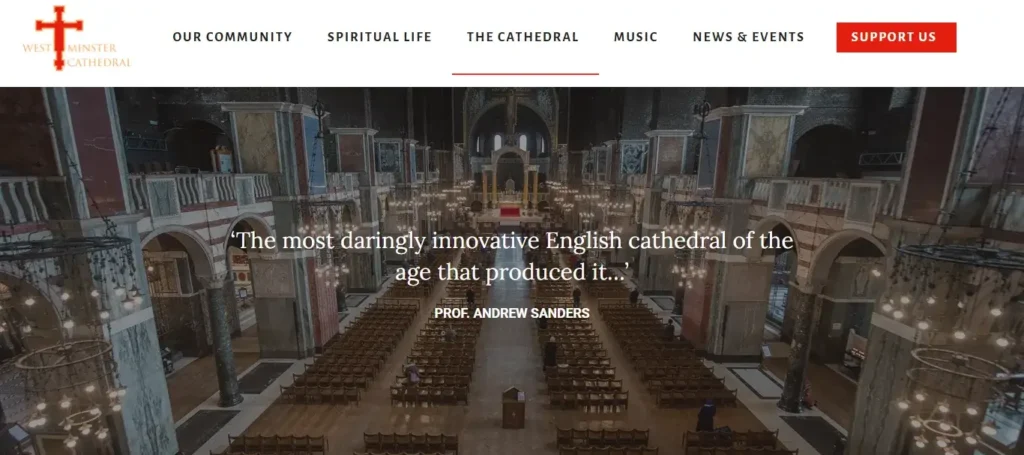
- Clean Design: A minimalist layout ensures information is easy to find.
- Multilingual Content: Multiple language support reflects London’s diversity.
- Spiritual Depth: Resources for prayer, sacraments, and homilies provide faith formation tools.
St. Mary’s Cathedral: Sydney, Australia
One of the most iconic Catholic churches in Australia, St. Mary’s has a website that reflects its grandeur while staying practical.
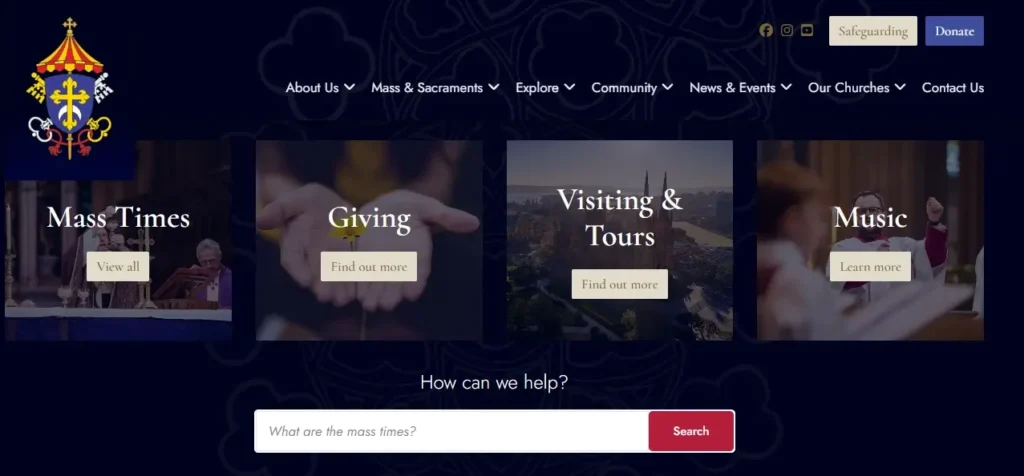
- Modern Meets Historic: The design balances the cathedral’s history with a contemporary, user-friendly layout.
- Engaging Features: Livestreamed services, photo galleries, and parish news keep the community engaged.
- Tourism-Friendly: Dedicated sections for visitors highlight the cathedral’s cultural and spiritual importance.
Notre-Dame Basilica: Montreal, Canada
Known for its breathtaking architecture, Notre-Dame Basilica extends that beauty into its online presence.
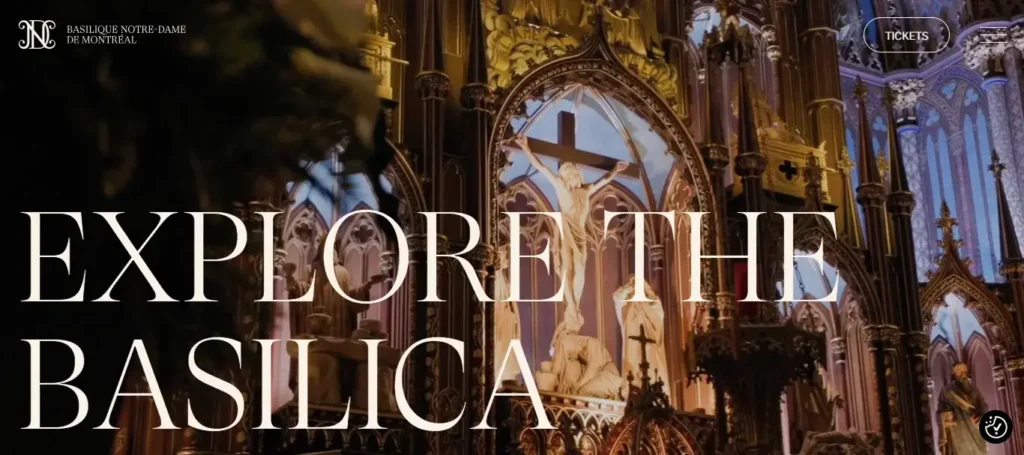
- Visually Striking: High-quality photography mirrors the basilica’s stunning interiors.
- Visitor-Friendly: Clear details on tours, mass times, and ticketing for concerts.
- Community Integration: A strong focus on both spiritual and cultural events.
Basilica of the Sacred Heart: Paris, France (Sacré-Cœur)
The Basilica of Sacré-Cœur is one of Paris’s most visited landmarks, and its website is equally compelling.
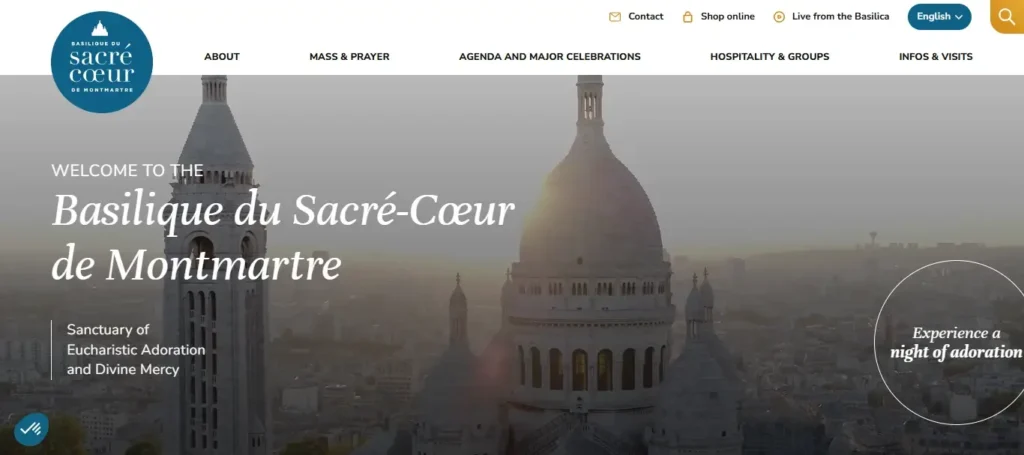
- Tourist Integration: Information for visitors is seamlessly combined with parish updates.
- Multimedia Experience: Virtual tours and livestreaming bring the basilica to a global audience.
- Spiritual Emphasis: Clear resources for prayer and confession reflect the basilica’s mission.
St. Andrew’s Catholic Church, Singapore
Singapore’s parishes are known for modernity and innovation, and St. Andrew’s website is no exception.
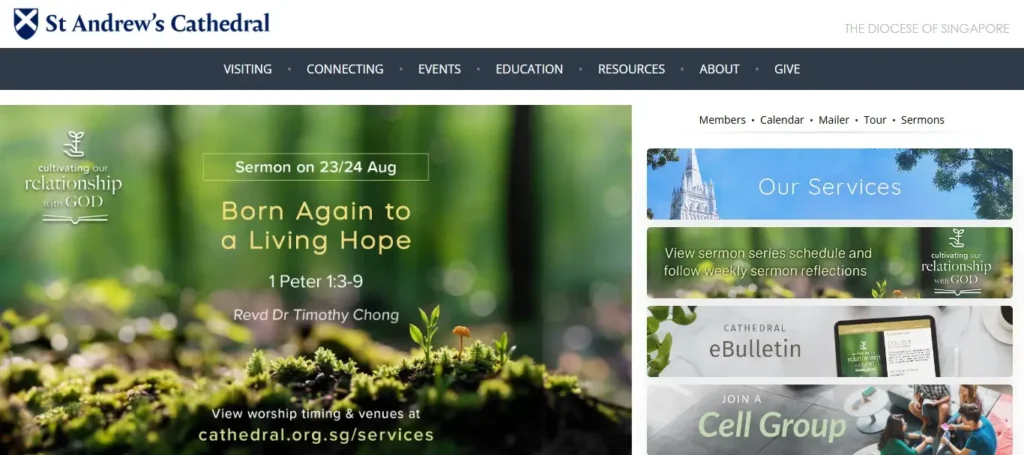
- Sleek and Modern: A contemporary design optimized for mobile-first users.
- Interactive Tools: Online registration for events, sacraments, and giving options.
- Engagement-Oriented: Regular blog updates and community stories foster connection.
Find out: WordPress Development Trends
Why These Global Examples Inspire?
These parish websites share several key traits despite being spread across different continents:
- Accessibility: Clear navigation and multilingual content make them welcoming to global audiences.
- Visual Storytelling: Photography and videos bring parish life, faith, and architecture to life.
- Practical Features: Online giving, livestreams, and event registration make faith more accessible.
- Balance of Tourism & Parish Needs: Especially in historic churches, sites cater to both spiritual seekers and tourists.
Learn: Complete Guide to Nonprofit Website Design
Tips for Building a Catholic Parish Website
When creating a new church website, you need to consider more than just aesthetics. Parishioners need easy access to mass schedules, event information, and online resources. Plus, visitors need a welcoming space that reflects the parish’s mission.
Building a Catholic parish website is both a spiritual and practical endeavor. It requires careful planning, audience understanding, thoughtful design, and ongoing maintenance.
By focusing on these elements, your parish can create a website that informs, inspires, and engages both parishioners and newcomers.
Tip 1: Understanding Your Audience
Before designing a parish website, it’s essential to know who will use it. A website serves families, young adults, seniors, and newcomers exploring faith.
- Importance of Knowing Your Audience: Ensures content resonates and meets visitor needs; even the most beautiful design fails if it’s not relevant.
- Tailoring Content for Different Groups: Families may prioritize children’s programs, young adults seek community activities, and seniors look for mass schedules or ministry updates.
- Tools to Understand Audience Needs: Use surveys, focus groups, and website analytics to gather insights and make informed design decisions.
Know about: Persona Website Design to Create Engaging Websites Tailored for Your Audience
Tip 2: Creating a Catholic Parish Website
Planning and building a parish website requires aligning design with mission, values, and audience needs.
- Planning Based on Mission & Audience: Define purpose; inform, engage, and inspire parishioners and newcomers.
- Choosing a Web Design Platform: WordPress CMS is popular for its flexibility, or you can choose custom-built web design solutions.
- Hosting and Domain Registration: Select reliable hosting and a memorable domain name aligned with the parish identity.
- Hiring a Professional: To design a responsive and functional website that aligns with goals, hiring a WordPress developer or an agency is often the best choice.
Tip 3: Designing a Welcoming Homepage
The homepage is the first impression and should immediately convey warmth and clarity.
- Importance of First Impressions: Reflect the parish’s personality, faith, and community spirit.
- Key Elements to Include: Mass schedules, upcoming events, ministry links, and contact information.
- Use of Images and Videos: Highlight parish life to foster community and connection.
- Clear Calls-to-Action: Encourage engagement with prompts like “Attend Mass,” “Volunteer,” or “Donate Online.”
Also read: Common Web Design Challenges and How to Tackle Them
Tip 4: Key Features of a Great Parish Website
A parish website should combine design, functionality, and accessibility.
- Clear and Concise Homepage: Communicate essential information quickly.
- Search Bar and Navigation: Ensure visitors can easily find what they need.
- Enhancing User Experience: Use photography, videos, and testimonials to create a welcoming atmosphere.
- Multilingual Support & Online Giving: Cater to diverse audiences and enable convenient contributions.
Explore: Fluid Design in Web Development
Tip 5: Website Localization
Localization ensures your website is relevant and accessible for diverse communities.
- Adapting for Regions or Languages: Provide local content and translations.
- Importance for Diverse Congregations: Inclusive content ensures all parishioners feel connected.
- SEO & Location-Based Optimization: Use local keywords to improve search visibility and attract parishioners.
Tip 6: Catholic Community Online
A parish website can foster engagement beyond Sunday services.
- Online Engagement Tools: Discussion forums, event registration, and social media integration.
- Faith Formation Resources: Prayer guides, educational content, and recorded sermons support spiritual growth.
- Encouraging Feedback & Interaction: Enable parishioners to share thoughts, ask questions, and feel invested.
Compare: Copywriting vs Content Writing
Tip 7: Catholic Parish Websites and SEO
SEO ensures your website is visible and reaches the right audience.
- Importance of SEO: Improves visibility and attracts new visitors.
- Effective SEO Techniques: Use location-specific keywords, optimize images & media, and create high-quality content.
- Ongoing Optimization: Regular updates and consulting experts maintain website performance over time.
Tip 8: Launch and Maintenance
Launching a website is just the beginning; ongoing maintenance ensures long-term success.
- Preparation for Launch: Test responsiveness, links, and accessibility across devices.
- Ongoing Maintenance: Update content, monitor analytics, and respond to user feedback.
- Continuous Improvement: Enhance content, usability, and features over time to reflect evolving parish needs.
Conclusion
Creating a welcoming and engaging parish website is essential for fostering community and sharing faith in today’s digital world. By focusing on mission, values, and the needs of your audience, your website can become a true reflection of parish life.
Incorporating essential features like clear navigation, online giving, and visual storytelling ensures accessibility and connection.
Moreover, regularly updating content, monitoring analytics, and applying SEO best practices will keep your website relevant, visible, and impactful.
With thoughtful design and consistent website care, a parish website becomes more than a tool; it becomes a vital extension of your ministry.
Catholic Parishes Website Design FAQs
What makes the best church websites stand out?
The best church websites feature a welcoming home page, a clear landing page, and mobile devices compatibility. They provide more videos, strong visuals, and relevant content so site visitors feel engaged and interested.
How do church leaders benefit from a parish website?
Church leaders can use a parish site as a digital house of communication and share updates, publish sermon recordings, or promote Catholic Hoos outreach programs. This ensures most parishes can keep their community informed beyond Sunday services.
Why is search engine visibility important for parish websites?
If a parish website doesn’t rank on the first page of search engines, it risks being overlooked. Optimized pages help interested people discover ministries, social outreach, or upcoming events when searching on laptops or cell phones.
What should not be missing from a parish website?
Every parish site should include a clear home page, updated bulletin board, and links to sermon recordings. Without these, it’s a missed opportunity to connect with visitors who rely on mobile devices to find information quickly.
Why does a church need a strong website?
A well-designed website (for example, Matthew Catholic Church) helps share critical information like mass times, events, and ministries. It also allows site visitors to easily navigate resources such as sermon recordings, the bulletin board, or social outreach opportunities. Without it, many parishes miss an opportunity to keep their community informed.
